Energy element method for large deflection analysis of arbitrarily shaped plates
IF 2.8
3区 工程技术
Q2 MECHANICS
International Journal of Non-Linear Mechanics
Pub Date : 2025-01-03
DOI:10.1016/j.ijnonlinmec.2024.105009
引用次数: 0
Abstract
The Ritz-based energy element method (EEM) is presented for large deflection analysis of arbitrarily shaped plates. The geometric model of an arbitrarily shaped plate is constructed by creating cutouts within a minimum rectangular domain covering the plate, in which a discrete energy system is established to simulate the plate based on the global admissible function, extended interval integral, Gauss quadrature, energy elements, and global variable stiffness. The energy element is defined to simulate strain energy of a rectangular subregion within the minimum rectangular domain, which contains a distinct number of Gauss points and allows geometric boundaries to pass through. Energy elements are generated by taking both the plate geometry and the distribution characteristic of Gauss points into consideration, resulting in a significant reduction of the required number of Gauss points than the Discrete Ritz method. By assigning variable stiffness properties on Gauss points, geometric boundaries of arbitrarily shaped plates can be captured in the numerical integration process. After removing the energy characterized by zero stiffness Gauss points out of the plate domain, the Gauss points based discrete model is constructed and the arbitrarily shaped plate can be simulated using discrete energy. The trust-region-dogleg method is utilized to solve the nonlinear algebraic equations of large deflection problem, and the numerical solution is produced. The solution procedures of EEM are standard and consistent applicable for plates of any shape. Comparisons regarding deflection and stresses with existing literature are presented.
任意形板大挠度分析的能量元法
提出了基于ritz能量元法的任意形状板的大挠度分析方法。通过在覆盖板的最小矩形域内创建切口,建立任意形状板的几何模型,并基于全局可容许函数、扩展区间积分、高斯正交、能量单元和全局变刚度建立离散能量系统来模拟任意形状板。能量元的定义是模拟最小矩形域内矩形子区域的应变能,该区域包含不同数量的高斯点,并允许几何边界通过。能量元的生成同时考虑了板的几何形状和高斯点的分布特性,比离散里兹法所需的高斯点数量显著减少。通过在高斯点上赋值变刚度特性,可以在数值积分过程中捕获任意形状板的几何边界。将以零刚度高斯点为特征的能量移出板域后,构建基于高斯点的离散模型,利用离散能量对任意形状的板进行模拟。利用信赖域-狗腿法求解了大挠度问题的非线性代数方程,并给出了数值解。EEM的解决程序是标准的,一致的适用于任何形状的板。比较有关挠度和应力与现有的文献提出。
本文章由计算机程序翻译,如有差异,请以英文原文为准。
求助全文
约1分钟内获得全文
求助全文
来源期刊
CiteScore
5.50
自引率
9.40%
发文量
192
审稿时长
67 days
期刊介绍:
The International Journal of Non-Linear Mechanics provides a specific medium for dissemination of high-quality research results in the various areas of theoretical, applied, and experimental mechanics of solids, fluids, structures, and systems where the phenomena are inherently non-linear.
The journal brings together original results in non-linear problems in elasticity, plasticity, dynamics, vibrations, wave-propagation, rheology, fluid-structure interaction systems, stability, biomechanics, micro- and nano-structures, materials, metamaterials, and in other diverse areas.
Papers may be analytical, computational or experimental in nature. Treatments of non-linear differential equations wherein solutions and properties of solutions are emphasized but physical aspects are not adequately relevant, will not be considered for possible publication. Both deterministic and stochastic approaches are fostered. Contributions pertaining to both established and emerging fields are encouraged.

 求助内容:
求助内容: 应助结果提醒方式:
应助结果提醒方式:


